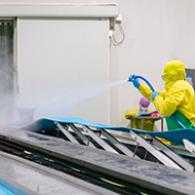What is the purpose of a Food Defense Program?
An effective food defense program in a processing and manufacturing facility will guarantee a safe food supply for the consumer. A successful program will embrace all aspects of the manufacturing process, from ingredient receipt to finished product shipping. Common program components are described in detail below.
1. Crisis Management Team
Each site should have a Crisis Management Team that comprises representatives from all staff levels. The Team is responsible for the implementation, adherence to, monitoring and regular review of the food defense program.
The Team should meet at established intervals, review all validation documentation and report on compliance success.
2. Facility Security
Protecting the food manufacturing process begins with a secure facility structure which includes external energy and water supplies. Areas of concern which require monitoring include (but are not limited to):
- Regular water testing for proper pH and chlorination.
- Water source securely protected with designated access only.
- External electrical supplies securely housed and protected.
- All facility entrance doors feature individual authorization devices.
- Air intakes and distribution systems inspected on a regular basis.
- Boiler chemicals approved and properly secured.
- Employee access restricted to assigned facility areas.
- Exterior facility grounds properly illuminated.
- TV monitoring of sensitive plant areas.
- A system in effect to record and track keys assigned to individuals.
- Plant grounds are fenced and secure with monitored entry and departure routes.
- Vehicle license plates may be photographed and recorded.
3. Human Variable
Ensuring only authorized personnel are present in external and internal facility areas is crucial to effective food security. Some program components which serve to address this issue may include the following:
- All employees should possess and prominently display a company-issued photo ID while on the facility grounds.
- Contractors and visitors should be signed in/out with a daily log and carry prominently displayed ID badges. These personnel may require a company escort where warranted.
- There is an effective employee termination process which includes retrieval of all access keys and immediate escort from facility grounds.
- All employees – both permanent and temporary - undergo a complete background check before entry permission is allowed.
- Employee training is conducted with emphasis on effective reaction to suspicious events or observance of unauthorized personnel on company property.
- Personal items (lunch boxes, etc) are allowed only in designated areas such as break rooms.

4. Ingredient Safety
Proper receiving and subsequent handling of product ingredients used in finished product formulation are critical to food safety. Finished product packaging materials should also be properly inspected and handled, beginning at the point of delivery. Safeguarding protocols may include the following:
- All received shipments feature sealed trailers and proper documentation from an approved supplier.
- Inspection of all received materials is performed and documented before unloading is permitted.
- Procedures are in place to handle such ingredients or packaging materials at the point of receipt which appear to be damaged or have a suspicious appearance.
- No opened ingredient packages are permitted in storage areas.
- All product labels are stored in a designated and secure area with access only to designated individuals. Inventories are monitored.
- There is a procedure in place to describe proper handling and use of imported materials.
- Ingredient lot numbers are traced through the entire manufacturing process from receipt to finished product.
5. Storage and Transportation Safety
The safe transportation and subsequent secure storage of ingredients, finished products, and chemicals require a system of protocols which should be in effect throughout the manufacturing and logistics chain.
- Food ingredients and allergen-containing additions are stored in designated and separate areas.
- Chemicals are stored in secure designated areas separate from food ingredients and finished products. Regular inventories are performed.
- Product returns, rework, etc. are held in clearly defined and designated areas – regular inventory accounting is performed.
- Transport trailers are evaluated for proper integrity and cleanliness before loading is permitted.
- Transport drivers are assigned to a designated driver reception area with denied access to other facility areas. 3rd party storage facilities are regularly inspected and maintained in accordance with company guidelines.
6. Food Process Security
There are many critical points in the actual food manufacturing process which must be controlled and validated to ensure finished product safety. Some of these points are described below.
- Unusual events during production shifts are recorded and investigated.
- Critical Controls Points (CCPs) are monitored by electronic recording devices with deviations handled according to established procedures.
- Process controllers and critical instruments should be passcode protected with designated access only.
- Small tools are inventoried at the beginning and end of each production shift with established procedures to deal with unaccounted for items.
- Computer formulation and addition programs are secure and access granted only to designated individuals with passcode authorization.
- Storage vessels in remote facility areas should be secure and alarmed to alert for attempted tampering.
- All operators are identified by official license documents.
- Mock recalls through the distribution system should be performed at regular intervals to ensure complete product traceability.
- Tamper evident packaging should be used where appropriate.
The Final Result: Consumer Food Safety
A successful program will embrace all aspects of the manufacturing process, from ingredient receipt to finished product shipping
Development and implementation of food defense programs and effective corrective actions are central to ensuring a safe food supply for our consuming public. SecureCheck from our Knowledge-based Services can help you achieve food safety excellence across all areas of your production process.









